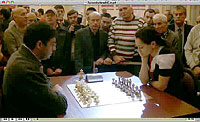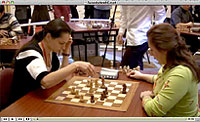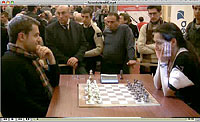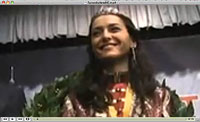The Chess Motif for all of the World - Feature Article
Alexandra Kosteniuk's Chess Blog for Daily Chess News and Trivia (c) 2013
Hello everyone,
Sometimes art imitates life; some games do so as well. In the case of chess especially, the parallels with power politics are many and uncanny, persisting over the centuries. Originating on the Asian subcontinent, chess moved to Persia (“checkmate” comes fromshah mat, “the king is dead”) but really began to diffuse widely during the great age of Arab conquest, starting in the 7th century of the Common Era. The structure and rules of the game remained consistent for centuries within Muslim domains, but in Christian countries to which chess spread, innovations emerged.
The most important change, introduced in the West some 500 years ago, granted greater directional flexibility and longer range to the Muslim “vizier,” renamed the queen, perhaps to reflect some of the great queens of the Middle Ages, like Eleanor of Aquitaine, as scholar Marilyn Yalom suggests in her highly entertaining Birth of the Chess Queen. The relabeled piece combined the capabilities of rook and bishop and, from a central position, could now exert influence over nearly half the board’s 64 squares, a ten-fold increase in power over the vizier.
This occurred on the chessboard at almost the same time that the long-range sailing vessel armed with heavy guns emerged, heralding the West’s rise to world mastery. Muslim powers never truly imitated this innovation — as they had failed to empower the vizier/queen along Western lines. Thus began their long decline in world politics. Now the real competition was between European powers. Spaniards, much of whose land had been occupied for centuries by Muslims, produced the earliest Western masters of the game in the 16th century — most notably Ruy López, for whom a famous, still popular, opening is named — and at the same time created the first globe-spanning empire.
In the following centuries, however, France and Britain produced the strongest chess masters — while simultaneously challenging and ultimately overmatching Spanish power on land and sea. The French no doubt picked up the game due to Spain’s proximity; the British may have had chess brought over by Norsemen, as the famous 12th century Isle of Lewis set — made of walrus ivory — features Viking “berserkers” as rooks. The Anglo-French competition proved exceptionally fierce, over the board and throughout the world. So while French and British troops contended, roughly evenly, over the futures of the Asian subcontinent, North America, and elsewhere, their chess masters, the best in the world, were of roughly equal strength as well. A chess figure of Napoleonic stature did arise — the famed Philidor — in the decades just before Bonaparte, but his death in 1795 kept the contending chess powers in balance. In the wake of Waterloo, the era in world politics known as the Pax Britannica was equaled in chess by the triumph of the Englishman Howard Staunton — the standard tournament chess piece design is named after him — over France’s Pierre de St. Amant.
This 1843 match was regarded as the first world championship, and there was much rejoicing among Britons, who saw in Staunton’s 11-6 victory an affirmation of their empire and world leadership. But all too soon the cheering faded. Staunton spent the late 1850s avoiding a match with the American chess prodigy Paul Morphy — a Bobby Fischer-like talent, and ultimately his equal in madness as well. Where Morphy signaled the rise of the United States as a chess and world power, there was much greater ferment in Germany and Austria. German-speakers, many of them Jewish, controlled the world championship until just after the end of World War I, while Nazi Germany’s team won the chess Olympiad held in Argentina on the eve of World War II. Alexander Alekhine, world champion from 1927-1945 with one brief interruption, was a Russian expatriate who played for the Reich and wrote horrible anti-Semitic articles in the wartime Pariser Zeitungabout how “Aryan chess” showed the fighting spirit and heralded the ultimate world triumph of German ways. Wrong.
In his last days, Alekhine recanted; his death in 1946 marked the start of a Russo-American chess rivalry that fully matched the bitterness of the Cold War. Soviet grandmasters generally held the advantage, but in 1972 Bobby Fischer came along and wrested the world title from Russian control — foreshadowing the ultimate collapse of the Soviet system. But after Fischer disappeared into his dementia, the Russians reasserted themselves for a while. Still, their greatest master of this late era, Garry Kasparov, was and is today a political dissenter. And the dissolution of the Soviet Union has sprinkled the products of its great chess combine throughout much of the world.
Some among the Russian chess diaspora landed in and brought fresh energy to the United States, but the most important American chess development of the post-Cold War period came from silicon-based intelligence: that is, IBM’s Deep Blue supercomputer, which narrowly defeated world champion Kasparov in a match in 1997.
Hello everyone,
Bobby Fischer, seated, ponders his next move as challenger Samuel Reshevsky paces during the 1963 U.S. Championship in New York. (Associated Press)
Sometimes art imitates life; some games do so as well. In the case of chess especially, the parallels with power politics are many and uncanny, persisting over the centuries. Originating on the Asian subcontinent, chess moved to Persia (“checkmate” comes fromshah mat, “the king is dead”) but really began to diffuse widely during the great age of Arab conquest, starting in the 7th century of the Common Era. The structure and rules of the game remained consistent for centuries within Muslim domains, but in Christian countries to which chess spread, innovations emerged.
The most important change, introduced in the West some 500 years ago, granted greater directional flexibility and longer range to the Muslim “vizier,” renamed the queen, perhaps to reflect some of the great queens of the Middle Ages, like Eleanor of Aquitaine, as scholar Marilyn Yalom suggests in her highly entertaining Birth of the Chess Queen. The relabeled piece combined the capabilities of rook and bishop and, from a central position, could now exert influence over nearly half the board’s 64 squares, a ten-fold increase in power over the vizier.
This occurred on the chessboard at almost the same time that the long-range sailing vessel armed with heavy guns emerged, heralding the West’s rise to world mastery. Muslim powers never truly imitated this innovation — as they had failed to empower the vizier/queen along Western lines. Thus began their long decline in world politics. Now the real competition was between European powers. Spaniards, much of whose land had been occupied for centuries by Muslims, produced the earliest Western masters of the game in the 16th century — most notably Ruy López, for whom a famous, still popular, opening is named — and at the same time created the first globe-spanning empire.
In the following centuries, however, France and Britain produced the strongest chess masters — while simultaneously challenging and ultimately overmatching Spanish power on land and sea. The French no doubt picked up the game due to Spain’s proximity; the British may have had chess brought over by Norsemen, as the famous 12th century Isle of Lewis set — made of walrus ivory — features Viking “berserkers” as rooks. The Anglo-French competition proved exceptionally fierce, over the board and throughout the world. So while French and British troops contended, roughly evenly, over the futures of the Asian subcontinent, North America, and elsewhere, their chess masters, the best in the world, were of roughly equal strength as well. A chess figure of Napoleonic stature did arise — the famed Philidor — in the decades just before Bonaparte, but his death in 1795 kept the contending chess powers in balance. In the wake of Waterloo, the era in world politics known as the Pax Britannica was equaled in chess by the triumph of the Englishman Howard Staunton — the standard tournament chess piece design is named after him — over France’s Pierre de St. Amant.
This 1843 match was regarded as the first world championship, and there was much rejoicing among Britons, who saw in Staunton’s 11-6 victory an affirmation of their empire and world leadership. But all too soon the cheering faded. Staunton spent the late 1850s avoiding a match with the American chess prodigy Paul Morphy — a Bobby Fischer-like talent, and ultimately his equal in madness as well. Where Morphy signaled the rise of the United States as a chess and world power, there was much greater ferment in Germany and Austria. German-speakers, many of them Jewish, controlled the world championship until just after the end of World War I, while Nazi Germany’s team won the chess Olympiad held in Argentina on the eve of World War II. Alexander Alekhine, world champion from 1927-1945 with one brief interruption, was a Russian expatriate who played for the Reich and wrote horrible anti-Semitic articles in the wartime Pariser Zeitungabout how “Aryan chess” showed the fighting spirit and heralded the ultimate world triumph of German ways. Wrong.
In his last days, Alekhine recanted; his death in 1946 marked the start of a Russo-American chess rivalry that fully matched the bitterness of the Cold War. Soviet grandmasters generally held the advantage, but in 1972 Bobby Fischer came along and wrested the world title from Russian control — foreshadowing the ultimate collapse of the Soviet system. But after Fischer disappeared into his dementia, the Russians reasserted themselves for a while. Still, their greatest master of this late era, Garry Kasparov, was and is today a political dissenter. And the dissolution of the Soviet Union has sprinkled the products of its great chess combine throughout much of the world.
Some among the Russian chess diaspora landed in and brought fresh energy to the United States, but the most important American chess development of the post-Cold War period came from silicon-based intelligence: that is, IBM’s Deep Blue supercomputer, which narrowly defeated world champion Kasparov in a match in 1997.
This may be a sign that American power will now be mostly measured — perhaps exercised as well — in high-tech terms. But maybe not. After its victory, Deep Blue “retired,” ducking new challenges much as Staunton fled from Morphy in the 1850s. Maybe there is an analog to this as well, given the sharp rise of anti-interventionist sentiments among average Americans — if not yet among their elected leaders.
Whatever path the United States follows, it is clear that there will be no American-led “new world order” such as President George H.W. Bush envisioned in 1991 after the lopsided victory won in Operation Desert Storm. Instead, the high politics of the 21st century appear to be in a state of flux, with the rise of new great powers like India and the return of older ones like Russia. This trend is clearly mirrored in chess, as the men’s world champion, Viswanathan Anand, is from India. The women’s title, held by Britain’s Vera Menchik until her untimely death in a Nazi buzz bomb attack in 1944, was won and kept by Russians until the end of the Cold War. But since then, though there has been one more Russian women’s champion, there have been four from China.
If my observation about chess-as-looking-glass holds as true in the future as it has in the past, fasten your seat belts. It’s going to be a bumpy century.
From Alexandra Kosteniuk's
www.chessblog.com
Whatever path the United States follows, it is clear that there will be no American-led “new world order” such as President George H.W. Bush envisioned in 1991 after the lopsided victory won in Operation Desert Storm. Instead, the high politics of the 21st century appear to be in a state of flux, with the rise of new great powers like India and the return of older ones like Russia. This trend is clearly mirrored in chess, as the men’s world champion, Viswanathan Anand, is from India. The women’s title, held by Britain’s Vera Menchik until her untimely death in a Nazi buzz bomb attack in 1944, was won and kept by Russians until the end of the Cold War. But since then, though there has been one more Russian women’s champion, there have been four from China.
If my observation about chess-as-looking-glass holds as true in the future as it has in the past, fasten your seat belts. It’s going to be a bumpy century.
This article is by John Arquilla is professor of defense analysis at the U.S. Naval Postgraduate School, author of Insurgents, Raiders, and Bandits: How Masters of Irregular Warfare Have Shaped Our World, and co-editor of Afghan Endgames: Strategy and Policy Choices for America’s Longest War.
From Alexandra Kosteniuk's
www.chessblog.com
Labels: Bobby Fischer, john arquilla, samuel reshevsky




































0 Comments:
Post a Comment
Note: Only a member of this blog may post a comment.
Subscribe to Post Comments [Atom]
<< Home